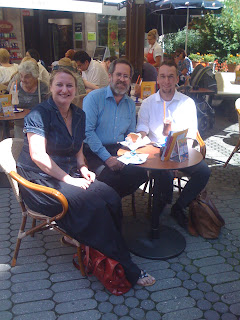I next traveled to Dubuque, Iowa for a family visit; I had last been in Dubuque a year ago. I took the 6:10 am Burlington Trailways bus from Chicago that arrived in Dubuque at 11:00. On this trip I stayed with my parents in the Luther Manor retirement home. I slept on the fold-out couch in the living room, which made things a bit crowded, but it was cheaper than a hotel room. I had most meals with the other Luther Manor residents.
One task during my stay was to sort through my stuff that I have stored in my parents’ garage. I managed to reduce the amount by two large cardboard boxes, by donating some books to the public library, throwing some papers away and taking an additional suitcase full of stuff back to Jordan, but there is still a lot of stuff from my years up through grad school that I have no use for, but cannot yet just discard. I also had dental appointments and a physical exam scheduled during my stay.
I went to Luther Seminary a couple of times to do some work on my Humayma reports in the library there.
I also started to watch a series of lectures about India, and especially early Buddhism, that were posted on the internet as video podcasts by the Asian Art Museum in San Francisco. Rani Sarma, my colleague in India, sent me the latest draft chapter of her book about early Buddhism in India, which I edited for her.
Sunday October 30 was family reunion day. My sister Linda and her friend Dennis came up from Iowa City and they as well as my brother John and his wife Renee joined Mom and Dad and me for church at St. Peters. Then we went to the restaurant at the Julien Inn downtown. Dad had invited Roger Bentley and his wife Marilyn to join us. Roger is a recently retired teacher and coach at Dubuque Senior High School, although I have no clear memory of him from high school days. Marilyn had worked with Mom on a number of volunteer activities over the years.
One task during my stay was to sort through my stuff that I have stored in my parents’ garage. I managed to reduce the amount by two large cardboard boxes, by donating some books to the public library, throwing some papers away and taking an additional suitcase full of stuff back to Jordan, but there is still a lot of stuff from my years up through grad school that I have no use for, but cannot yet just discard. I also had dental appointments and a physical exam scheduled during my stay.
I went to Luther Seminary a couple of times to do some work on my Humayma reports in the library there.
Luther in a Halloween costume
I also started to watch a series of lectures about India, and especially early Buddhism, that were posted on the internet as video podcasts by the Asian Art Museum in San Francisco. Rani Sarma, my colleague in India, sent me the latest draft chapter of her book about early Buddhism in India, which I edited for her.
Sunday October 30 was family reunion day. My sister Linda and her friend Dennis came up from Iowa City and they as well as my brother John and his wife Renee joined Mom and Dad and me for church at St. Peters. Then we went to the restaurant at the Julien Inn downtown. Dad had invited Roger Bentley and his wife Marilyn to join us. Roger is a recently retired teacher and coach at Dubuque Senior High School, although I have no clear memory of him from high school days. Marilyn had worked with Mom on a number of volunteer activities over the years.
Roger Bentley, Renee, John, me and Linda on the left, Marilyn Bentley, Mom, Dad and Dennis on the right.
The Schick family
On Wednesday afternoon November 2 I traveled to Chicago for a night flight back to Jordan. I decided to take the Burlington Trailways bus to Rockford and then to take the Van Gelder bus from Rockford directly to O’Hare. That worked for my 10:00 pm flight back to Jordan with stopovers in Heathrow and Frankfurt on November 3.





















































